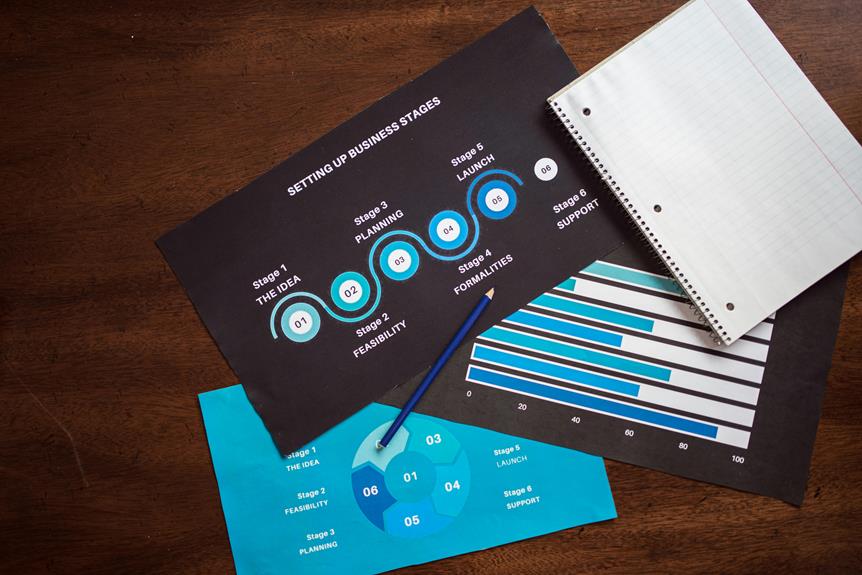When conducting a competitor SEO audit, start by identifying who your true competitors are, not just those you assume. You'll want to use tools like SEMrush or Ahrefs to gather data on their website structure and keyword performance. But don't stop there—assessing site speed, mobile usability, and indexing status will also offer valuable insights. Synthesizing this information into a strategic report can set the stage for enhancing your own SEO efforts. Curious about how to transform this data into actionable steps? There's much more to explore in crafting a winning SEO strategy.
Identify Competitors
Before diving into an SEO audit, it's crucial to identify your competitors accurately. Start by defining your target keywords. These are the terms customers use when searching for products or services like yours. Utilize tools like Google Keyword Planner or SEMrush to gather a list of relevant keywords, ensuring they reflect your industry, niche, and audience intent.
Next, conduct a search using these keywords to spot competitors ranking on the first page of search results. Pay attention to both direct competitors—businesses offering similar products—and indirect competitors—those vying for the same audience. Tools such as Ahrefs or Moz can help you analyze SERP features and domain authority, providing essential insights into who truly competes for your target keywords.
It's important to differentiate between perceived competitors and actual SEO competitors. While you might think certain businesses are your competitors based on industry knowledge, data-driven analysis often reveals unexpected players. By examining backlink profiles, domain ratings, and organic traffic estimates, you can identify those who are genuinely competing for your audience's attention.
Furthermore, leverage competitive analysis tools like SpyFu to uncover keyword overlap and similarities in content strategies. These insights will help you understand competitors' strengths and weaknesses, which is fundamental in crafting your own SEO strategy.
Analyze Website Structure

When analyzing website structure, start by examining key elements like URL hierarchy, navigation, and internal linking, as these factors significantly influence search engine crawlability and user experience. A well-organized URL hierarchy aids search engines in comprehending the context and depth of site content, impacting indexing efficiency.
Analyze how competitors structure their URLs—do they use clear, keyword-rich paths or complex parameters? For instance, a consistent, hierarchical URL structure like example.com/category/subcategory/product offers clarity and SEO advantages.
Next, scrutinize the site's navigation system. Efficient navigation ensures users and search engines can easily access all parts of the site. Check if competitors use breadcrumb navigation, which enhances both usability and SEO by providing a clear path back to previous pages.
Evaluate the primary and secondary navigation menus—are they intuitive and easy to follow? A seamless navigation structure often correlates with lower bounce rates and higher user engagement.
Internal linking is another critical factor. It helps distribute page authority and guides visitors through content. Analyze how competitors link internally—do they employ contextual linking strategies?
An effective internal linking structure not only boosts SEO by spreading link equity but also reduces the number of clicks needed to reach deeper content. Tools like Screaming Frog or Ahrefs can help identify these linking strategies and the overall link depth of a competitor's site.
Assess Site Speed

Evaluating site speed is crucial since it directly impacts user experience, SEO rankings, and conversion rates. When conducting a competitor SEO audit, dive into their site speed metrics to understand how they stack up against industry standards and your own site's performance. Use tools like Google PageSpeed Insights, GTmetrix, or Pingdom to gather data on their load times, both on desktop and mobile platforms.
Start by analyzing key metrics such as First Contentful Paint (FCP), Largest Contentful Paint (LCP), Time to Interactive (TTI), and Total Blocking Time (TBT). These metrics give you insight into how quickly a page starts to display content, when the main content is fully rendered, when a user can start interacting with the page, and how much time is spent blocking user input, respectively.
Look for scores and benchmarks provided by these tools to see where competitors excel or falter. Additionally, examine server response times, which should ideally be under 200 milliseconds. Slow server response can significantly affect overall site speed.
Assess the use of compression techniques like gzip, image optimization strategies, and caching policies. These factors contribute heavily to page load efficiency. Next, scrutinize their use of Content Delivery Networks (CDNs). CDNs reduce latency by serving content from servers closest to the user, which can greatly enhance speed.
Check if competitors are leveraging this technology effectively. Lastly, compile these findings into a report. Highlight areas where competitors outperform or lag behind. This will help you pinpoint opportunities to enhance your own site's speed, ensuring you remain competitive in search engine rankings and user satisfaction.
Review Mobile Usability

As mobile usage continues to rise, reviewing mobile usability becomes an indispensable step in a competitor SEO audit. You need to ensure that your competitor's site is optimized for mobile devices, as Google uses mobile-first indexing.
Begin by analyzing their website using tools like Google's Mobile-Friendly Test. This tool provides insights into how well their site performs on mobile devices, highlighting areas that fail to meet Google's mobile usability standards.
Next, evaluate the site's design responsiveness. Check if the layout adjusts seamlessly across different screen sizes. Use browser developer tools to simulate various devices and inspect elements like navigation, buttons, and forms. Ensure that all these elements are touch-friendly and spaced adequately to prevent accidental clicks.
Examine the loading times on mobile networks. You can use tools like PageSpeed Insights to gather data on their mobile page performance. Pay attention to metrics such as First Contentful Paint (FCP) and Time to Interactive (TTI), as these influence user experience and search ranking.
A competitive mobile page should load quickly, ideally within three seconds, to minimize bounce rates.
Additionally, assess the use of mobile-specific features like Accelerated Mobile Pages (AMP). AMP can significantly enhance load speeds and improve user experience. Identify if your competitor is leveraging these features, which could give them an edge in mobile search results.
Check Indexing Status

Understanding the indexing status of your competitor's website is crucial for a comprehensive SEO audit. It provides insights into how well their pages are being crawled and indexed by search engines, directly impacting their visibility.
Start by using the "site:" operator in Google Search to see how many pages are indexed. Type "site:competitorwebsite.com" in the search bar, and you'll get a rough count of indexed pages. Compare this number with the total pages on their site to assess the indexing efficiency.
For a more technical approach, use tools like Google Search Console (if you have access) to view the indexed pages and any crawling issues. If access isn't possible, tools like Ahrefs or SEMrush can estimate indexed pages and highlight potential issues like crawl anomalies or blocked pages.
Pay attention to discrepancies between the number of pages submitted in sitemaps and the number indexed, as this reveals optimization opportunities.
Analyze the robots.txt file and meta tags of your competitor's pages to identify which pages they're intentionally excluding from indexing. This could indicate strategic content exclusions or technical misconfigurations.
Delve into their XML sitemap to confirm it's well-structured and up-to-date, promoting efficient crawling.
Lastly, evaluate their site structure for deep or isolated pages that might hinder indexing. A flat, well-organized structure facilitates better crawlability.
Conclusion
In your quest to outshine competitors, remember Achilles' heel; even the strongest have vulnerabilities. By identifying competitors, analyzing site structures, assessing speed, reviewing mobile usability, and checking indexing status, you gain a data-driven edge. Uncover their weaknesses and fortify your SEO strategy with precision. Use these insights to craft a robust plan, ensuring your site not only meets but exceeds industry standards. Seize this opportunity to transform insights into strategic victories.


